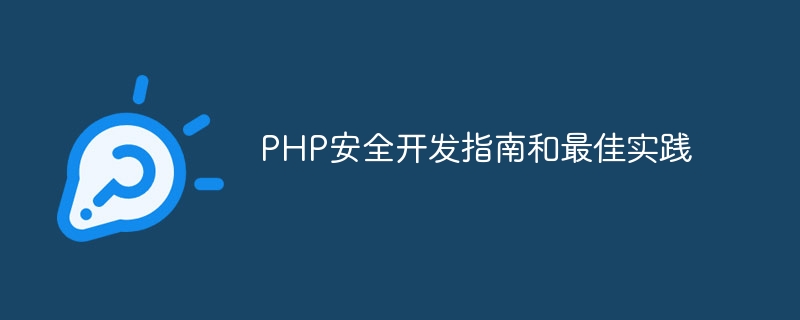

PHP Security Development Guidelines and Best Practices
Introduction:
With the rapid development of the Internet, PHP, as a widely used programming language, is being More and more developers love and apply it. However, due to the ease of use and flexibility of PHP, some security issues have arisen. This article will introduce some guidelines and best practices for PHP security development to help developers improve the security of their code. At the same time, the code examples involved in this article will also help readers better understand these secure development concepts and practices.
1. Input verification
Input verification is an important part of ensuring data security. Before receiving user input, it should be validated and filtered to prevent malicious or erroneous data from entering the system. The following is a simple input validation code example:
$user_input = $_POST['user_input'];
if (empty($user_input)) {
die('请输入有效的数据');
}
$filtered_input = filter_var($user_input, FILTER_SANITIZE_STRING);
// 继续处理过滤后的数据In the above example code, we first check whether the user input is empty, and if it is empty, the user is prompted to enter valid data. Then use the filter_var function to filter the user input. Here the FILTER_SANITIZE_STRING filter is used, which will remove all tags and special characters.
2. Prevent SQL Injection
SQL injection is a common security vulnerability that obtains unauthorized data by injecting malicious code into SQL statements. To prevent SQL injection, we should use prepared statements or parameterized queries. The following is an example of using prepared statements:
// 假设 $db 是一个已经建立好的数据库连接对象
$user_input = $_POST['user_input'];
$stmt = $db->prepare("SELECT * FROM users WHERE username = ?");
$stmt->bind_param("s", $user_input);
$stmt->execute();
$result = $stmt->get_result();
// 处理查询结果The above code binds user input to placeholders in the SQL query statement, ensuring the security of the input. By using prepared statements, we can prevent malicious code from being injected into SQL statements.
3. Prevent cross-site scripting attacks (XSS)
Cross-site scripting attacks are a common attack method for attackers to obtain user information by embedding malicious scripts in web pages. In order to prevent cross-site scripting attacks, we should filter and escape the output data. The following is a sample code to prevent XSS attacks:
$user_input = $_POST['user_input']; $escaped_input = htmlspecialchars($user_input, ENT_QUOTES, 'UTF-8'); echo $escaped_input;
In the above code, we use the htmlspecialchars function to escape user input to ensure that the output content is not parsed as a malicious script .
4. File upload security
The file upload function is a common function in many websites, but it is also a potential security risk. In order to ensure the security of the file upload function, we need to strictly verify and filter the files. The following is a sample code for file upload:
$file = $_FILES['uploaded_file'];
// 验证文件类型和大小
$allowed_types = ['image/jpeg', 'image/png'];
$max_size = 1024 * 1024; // 限制为1MB
if (!in_array($file['type'], $allowed_types) || $file['size'] > $max_size) {
die('非法的文件类型或文件过大');
}
// 将文件移动到指定目录
$upload_path = '/path/to/uploads/';
$new_filename = uniqid() . '_' . $file['name'];
if (move_uploaded_file($file['tmp_name'], $upload_path . $new_filename)) {
echo '文件上传成功';
} else {
die('文件上传失败');
}In the above code, we first verify whether the type and size of the uploaded file are legal. Then use the move_uploaded_file function to move the file to the specified directory. It is worth noting that we use the uniqid function in the target file name to generate a unique file name to avoid overwriting problems with files with the same name.
Conclusion:
This article introduces some guidelines and best practices for PHP security development, including input validation, preventing SQL injection, preventing cross-site scripting attacks and file upload security. By following these guidelines and practices, developers can improve the security of their code and protect user data. Of course, security development is not limited to these contents. Developers should also always pay attention to the latest security vulnerabilities and attack methods, and take corresponding protective measures in a timely manner to ensure the security of the system.
The above is the detailed content of PHP security development guidelines and best practices. For more information, please follow other related articles on the PHP Chinese website!




